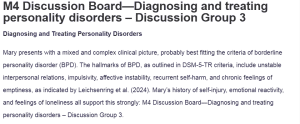M4 Discussion Board—Diagnosing and treating personality disorders – Discussion Group 3
Diagnosing and Treating Personality Disorders
Mary presents with a mixed and complex clinical picture, probably best fitting the criteria of borderline personality disorder (BPD). The hallmarks of BPD, as outlined in DSM-5-TR criteria, include unstable interpersonal relations, impulsivity, affective instability, recurrent self-harm, and chronic feelings of emptiness, as indicated by Leichsenring et al. (2024). Mary’s history of self-injury, emotional reactivity, and feelings of loneliness all support this strongly: M4 Discussion Board—Diagnosing and treating personality disorders – Discussion Group 3.
Her oversensitivity to perceived criticism and the impulse to act, for example, by scratching her arms when distressed emotionally, further align with BPD symptoms. Additionally, her childhood history of parental divorce and severed maternal relationships may contribute to her current emotional dysregulation and interpersonal challenges.
Differential Diagnoses
Differential diagnoses that would be considered are major depressive disorder (MDD), generalized anxiety disorder (GAD), and post-traumatic stress disorder (PTSD). While Mary reports panic, depression, and anxiety, these symptoms may overlap with or stem from the affective dysregulation that is part of BPD. Bipolar disorder should also be ruled out due to the possible mood instability. In addition, substance use disorder related to binge drinking and possible trauma history should be evaluated as contributing factors (American Psychiatric Association, 2022).
Medication Recommendations
Notably, although no medications are approved by the FDA specifically for BPD, pharmacological interventions may target co-occurring symptoms. Based on the work of Edinoff et al. (2021), in treatment, SSRIs such as sertraline or fluoxetine can be considered in reducing her depressive and anxiety symptoms, while low-dose atypical antipsychotics like aripiprazole or mood stabilizers such as lamotrigine may help with emotional dysregulation. Caution is also required to prevent polypharmacy, and medications should be an adjunct to psychotherapy rather than the treatment of choice.
Treatment of Choice and Person-Centered Approach
Dialectical Behavior Therapy (DBT), an evidence-based psychotherapy intended to address symptoms of borderline personality disorder (BPD), namely self-harming behaviours and emotional dysregulation, is Mary’s preferred treatment. DBT teaches distress tolerance, emotional regulation, and interpersonal effectiveness skills, which may enable Mary to handle her emotional responses and develop better relationships with others (Lee et al., 2022). A person-centred approach would be congruent with DBT in an environment of nonjudging and empathetic therapy, validatory of Mary’s experiences, and predominantly focused on her autonomy in treatment decisions. This fosters cooperation and makes Mary feel understood and involved in her recovery process.
References
American Psychiatric Association. (2022). Diagnostic and Statistical Manual of Mental Disorders (DSM-5-TR). Psychiatry.org; American Psychiatric Association. https://www.psychiatry.org/psychiatrists/practice/dsm
Edinoff, A. N., Akuly, H. A., Hanna, T. A., Ochoa, C. O., Patti, S. J., Ghaffar, Y. A., Kaye, A. D., Viswanath, O., Urits, I., Boyer, A. G., Cornett, E. M., & Kaye, A. M. (2021). Selective Serotonin Reuptake Inhibitors and Adverse Effects: A Narrative Review. Neurology International, 13(3), 387–401. https://doi.org/10.3390/neurolint13030038
Lee, R. K., Harms, C. A., & Jeffery, S. E. (2022). The contribution of skills to the effectiveness of dialectical behavioral therapy. Journal of Clinical Psychology, 78(12). https://doi.org/10.1002/jclp.23349
Leichsenring, F., Fonagy, P., Heim, N., Kernberg, O. F., Leweke, F., Luyten, P., Salzer, S., Spitzer, C., & Steinert, C. (2024). Borderline personality disorder: a comprehensive review of diagnosis and clinical presentation, etiology, treatment, and current controversies. World Psychiatry: Official Journal of the World Psychiatric Association (WPA), 23(1), 4–25. https://doi.org/10.1002/wps.21156
ORDER A PLAGIARISM-FREE PAPER HERE
We’ll write everything from scratch
Question
Mary (28 years old) comes to see the PMHNP and says, “I need a new provider!” She has a history of panic, depression, and anxiety. She recently became upset with her boyfriend whom she thought was making negative statements about her, at which time, she went in the bedroom and began scratching her arms with a fork. She scratched hard enough to draw blood.
She is now sorry that she did this and thinks she may have over-reacted. She admits to a history of cutting herself. She took an overdose of sleeping pills when she was 14 and was subsequently hospitalized. She has taken various SSRIs over the past 10 years, and she has a history of occasional binge drinking.

M4 Discussion Board—Diagnosing and treating personality disorders – Discussion Group 3
Her parents divorced when she was 12 years of age and has since severed any relationship with her mother and only talks to her dad. She tells the PMHNP that she feels lonely and “alone”.
- The appropriate personality disorder diagnosis would be:
- What differential diagnoses should be considered?
- What medication, if any, should she be prescribed? Why or why not?
- What is the treatment of choice for this patient, and how does the person-centered approach to therapy align with this treatment?
Resource:
- DSM-5-TR text

